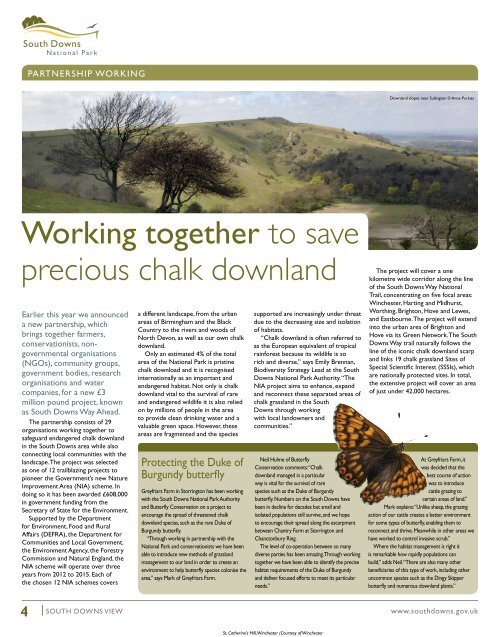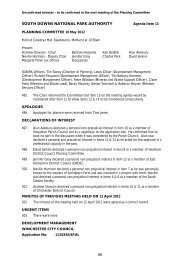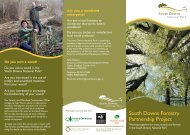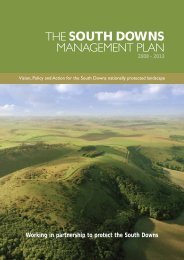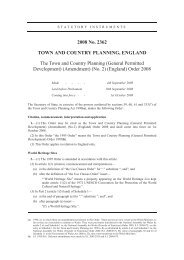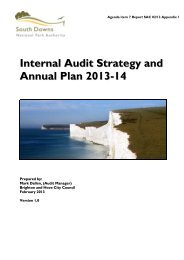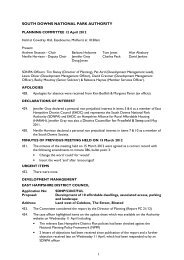partnership workingDownland slopes near Sullington © Anne PurkissWorking together to saveprecious chalk downlandEarlier this year we announceda new partnership, whichbrings together farmers,conservationists, nongovernmentalorganisations(NGOs), community groups,government bodies, researchorganisations and watercompanies, for a new £3million pound project, knownas <strong>South</strong> <strong>Downs</strong> Way Ahead.The partnership consists of 29organisations working together tosafeguard endangered chalk downlandin the <strong>South</strong> <strong>Downs</strong> area while alsoconnecting local communities with thelandscape. The project was selectedas one of 12 trailblazing projects topioneer the Government’s new NatureImprovement Area (NIA) scheme. Indoing so it has been awarded £608,000in government funding from theSecretary of State for the Environment.Supported by the Departmentfor Environment, Food and RuralAffairs (DEFRA), the Department forCommunities and Local Government,the Environment Agency, the ForestryCommission and Natural England, theNIA scheme will operate over threeyears from 2012 to 2015. Each ofthe chosen 12 NIA schemes coversa different landscape, from the urbanareas of Birmingham and the BlackCountry to the rivers and woods ofNorth Devon, as well as our own chalkdownland.Only an estimated 4% of the totalarea of the <strong>National</strong> <strong>Park</strong> is pristinechalk download and it is recognisedinternationally as an important andendangered habitat. Not only is chalkdownland vital to the survival of rareand endangered wildlife it is also reliedon by millions of people in the areato provide clean drinking water and avaluable green space. However, theseareas are fragmented and the speciesProtecting the Duke ofBurgundy butterflyGreyfriars Farm in Storrington has been workingwith the <strong>South</strong> <strong>Downs</strong> <strong>National</strong> <strong>Park</strong> <strong>Authority</strong>and Butterfly Conservation on a project toencourage the spread of threatened chalkdownland species, such as the rare Duke ofBurgundy butterfly.“Through working in partnership with the<strong>National</strong> <strong>Park</strong> and conservationists we have beenable to introduce new methods of grasslandmanagement to our land in order to create anenvironment to help butterfly species colonise thearea,” says Mark of Greyfriars Farm.supported are increasingly under threatdue to the decreasing size and isolationof habitats.“Chalk downland is often referred toas the European equivalent of tropicalrainforest because its wildlife is sorich and diverse,” says Emily Brennan,Biodiversity Strategy Lead at the <strong>South</strong><strong>Downs</strong> <strong>National</strong> <strong>Park</strong> <strong>Authority</strong>. “TheNIA project aims to enhance, expandand reconnect these separated areas ofchalk grassland in the <strong>South</strong><strong>Downs</strong> through workingwith local landowners andcommunities.”Neil Hulme of ButterflyConservation comments: “Chalkdownland managed in a particularway is vital for the survival of rarespecies such as the Duke of Burgundybutterfly. Numbers on the <strong>South</strong> <strong>Downs</strong> havebeen in decline for decades but small andisolated populations still survive, and we hopeto encourage their spread along the escarpmentbetween Chantry Farm at Storrington andChanctonbury Ring.The level of co-operation between so manydiverse parties has been amazing. Through workingtogether we have been able to identify the precisehabitat requirements of the Duke of Burgundyand deliver focused efforts to meet its particularneeds.”The project will cover a onekilometre wide corridor along the lineof the <strong>South</strong> <strong>Downs</strong> Way <strong>National</strong>Trail, concentrating on five focal areas:Winchester, Harting and Midhurst,Worthing, Brighton, Hove and Lewes,and Eastbourne. The project will extendinto the urban area of Brighton andHove via its Green Network. The <strong>South</strong><strong>Downs</strong> Way trail naturally follows theline of the iconic chalk downland scarpand links 19 chalk grassland Sites ofSpecial Scientific Interest (SSSIs), whichare nationally protected sites. In total,the extensive project will cover an areaof just under 42,000 hectares.At Greyfriars Farm, itwas decided that thebest course of actionwas to introducecattle grazing tocertain areas of land.”Mark explains: “Unlike sheep, the grazingaction of our cattle creates a better environmentfor some types of butterfly, enabling them toreconnect and thrive. Meanwhile in other areas wehave worked to control invasive scrub.”Where the habitat management is right itis remarkable how rapidly populations canbuild,” adds Neil. “There are also many otherbeneficiaries of this type of work, including otheruncommon species such as the Dingy Skipperbutterfly and numerous downland plants.”4south downs <strong>View</strong>www.southdowns.gov.ukSt. Catherine’s Hill, Winchester (Courtesy of Winchester
partnership workingSt Caths ShepherdingWinchester Conservation Skills ProjectPhoto © Dave RumbleThe <strong>South</strong> <strong>Downs</strong> Way Ahead partnership aims to work with local communities to reconnect themwith their surrounding landscape and encourage them to take an active role in restoring chalk grassland.One such engagement scheme is the Winchester Conservation Skills Project. Managed by theHampshire and Isle of Wight Wildlife Trust, the initiative helps set up local volunteer groups and trainsthem to carry out valuable conservation work in the River Itchen area.David Rumble of the Hampshire and Isle of Wight Wildlife Trust explains: “We aim to educate andsupport volunteers in all areas of conservation, from traditional countryside skills, like coppicing, hedgelaying and fencing to livestock welfare checking ‘lookering’, scrub management and the maintenance ofhistorical structures.”As well as providing an opportunity to learn new skills, the scheme aims to help people from urbancommunities to understand, value and feel more confident about accessing the landscape.The volunteers also make a vital contribution to work carried out by organisations like the Trust.“The work of our volunteers has helped to secure the future of many precious habitats and species,such as the <strong>South</strong>ern Damselfly, Water Vole and Chalk Hill Blue Butterfly, enabling them to thrive again,”comments David.Anyone can volunteer to be involved in the scheme, which is due to start this summer. For moreinformation please visit www.hwt.org.ukWater © Pete CurrellImproving groundwaterqualityThere are 1.2 million people living in andaround the <strong>National</strong> <strong>Park</strong> that depend on waterfiltered through and stored in the <strong>South</strong> <strong>Downs</strong>chalk downland, but several of our groundwatercatchments are suffering from poor water quality.The <strong>South</strong> <strong>Downs</strong> Way Ahead project willsupport farmers and water companies to worktogether to identify and target land managementactivity to improve groundwater quality, forexample, by restoring wetland and chalk grasslandhabitats or by growing specific crops.“Many people in the area do not realise thatthe water they are drinking comes from the chalkdownland around us,” says Sean Ashworth fromthe Environment Agency. “Through the <strong>South</strong><strong>Downs</strong> Way Ahead partnership we hope toengage with local communities about how we canwork together to look after our groundwater.”The Environment Agency is already workingclosely with local farmers and landowners acrossthe <strong>National</strong> <strong>Park</strong> to offer advice on effectiveland management and practices that won’t havea negative effect on groundwater; the <strong>South</strong><strong>Downs</strong> Way Ahead project will build on thiswork. “By using sensitive management techniquesand getting good advice on fuel storage and farmrun off where it’s needed, we can help improvethe groundwater in the area,” explains Sean.Groundwater quality monitoring alreadyundertaken regularly by the Environment Agencyand water companies will be used to measure theproject’s success.A spring at FulkingThe main objectives of the <strong>South</strong><strong>Downs</strong> Way Ahead project are to:• restore and enhance chalk downlandfor endangered species and habitats.• improve water quality throughappropriate land management.• encourage communities to takean active role in looking after thelandscape.Each part of the project will involvedifferent organisations from within thepartnership working together to createa more joined-up habitat.The <strong>South</strong> <strong>Downs</strong> <strong>National</strong> <strong>Park</strong><strong>Authority</strong> is leading the partnership,spearheaded by members of the teamsuch as Area Manager, Nigel James, whocomments: “The success of landscapescaleprojects such as the <strong>South</strong><strong>Downs</strong> Way Ahead NIA is completelydependent on a wide range of partnersworking together to achieve a commonvision. The depth and breadth of thepartnership shows the high level ofenthusiasm and commitment that thesepartners have to achieve the commonvision of restoring and reconnecting thechalk habitats of the <strong>South</strong> <strong>Downs</strong>.”As well as bringing together partnerorganisations, the project also aims toconnect with the wider community ofpeople living in and around the <strong>South</strong><strong>Downs</strong> <strong>National</strong> <strong>Park</strong>. New engagementinitiatives have been developed toeducate and inspire local communitiesto take an active role in helping torestore and conserve the landscape inwhich they live.NIA PartnersThe NIA is made up of a partnership of 29 organisations from across the <strong>South</strong><strong>Downs</strong> <strong>National</strong> <strong>Park</strong>. The partners are:Arun and Rother Rivers Trust(ARRT), Brighton and Hove CityCouncil, Butterfly Conservation,Environment Agency, EastbourneBorough Council, Forest Research,Games & Wildlife Conservation Trust,Hampshire Biodiversity InformationCentre (Hbic), Hampshire & Isle ofWight Wildlife Trust, Kew Wakehurst,University of Leeds, Lewes & OuseValley eco-nomics, Lewes DistrictCouncil, <strong>National</strong> Trust, NaturalEngland, Portsmouth Water,Rural Economy and Land UseProgramme (relu), RSPB, SussexBiodiversity Record Centre, <strong>South</strong><strong>Downs</strong> Land Management Group,<strong>South</strong> <strong>Downs</strong> Network, <strong>South</strong> <strong>Downs</strong><strong>National</strong> <strong>Park</strong> <strong>Authority</strong>, <strong>South</strong> <strong>Downs</strong>Society, <strong>South</strong> East Water, <strong>South</strong>ernWater, Sussex Wildlife Trust, SteyningDownland Scheme, University ofBrighton, Winchester City Councilwww.southdowns.gov.uk south downs <strong>View</strong> 5


